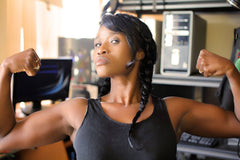Running While Female

According to a survey published by Runner’s World in 2017, 43% of women have experienced harassment when running. For women under the age of 30, that number rises to 58%.
Incidentally, only 4% of men reported similar harassment.
The title Running While Female is odd in its wording, but that’s exactly what women across the US, UK and the world are typing into Google each month. These women aren’t looking for tips on running techniques or seeking advice on how to run during pregnancy or during their period. It’s not women trying to understand the mechanics of sports bras or the effect that jogging has on bones, ligaments or breasts. It’s a very specific enquiry and one often used because they’ve been harassed.When women ask about Running While Female on the internet, and when they find the Runner’s World survey, they’re looking for advice and support about staying safe. They’re looking for validation of their own experiences. Women often normalise harassment but when it’s hurtful, intimidating or threatening, then it’s important to find acknowledgement amongst others with similar experiences.
It’s important even if the harassment seems minor. Women are regularly told that they should be flattered by a catcall BUT it’s rarely flattering. A compliment empowers the person receiving the attention but a catcall is often about empowering the individual shouting it across a public space. Telling people you’ve been upset or annoyed by a catcall during a run can be as frustrating as receiving it in the first place: most people don’t see what the big deal is.

Any form of street harassment is annoying. It can get into our head and make it harder to concentrate on form. It can make the calm you’re trying to find more elusive. The indignity or anger it brings can often follow you around long after you’ve taken off your running shoes. It’s enough for some women to take their workout indoors.
The Murder of Mollie Tibbets
20-year-old student Mollie Tibbets went for a run one evening in July of last year. She had no reason to believe that she was in any danger until a man began following her. When he started harassing her, she held out her phone and threatened to call the police.
Soon after, he killed her.
Talya Minsberg wrote about it for the New York Times and about what it meant to her, her sister and the countless other women in the United States who regularly run alone. She wrote about the murder as a reminder that what happened to Mollie Tibbets could easily happen to her and to any woman daring to lace up their running shoes and go outside alone.
The murder echoed what had happened in the US in 2016 when three female joggers were killed in a single nine-day period. Aside from their youth and gender, the biggest thing that the three women had in common was that they’d been running when it happened.
Runner's World Survey Results
MPR News wrote about the Runners World survey the results saying:
“Thirty percent of female runners say they've been followed by another person either in a vehicle, bicycle or on foot; 18 percent have been sexually propositioned during a run.”
The BBC reported on the Runners World survey, too, adding that as a result of harassment:
“the vast majority of women said these fears led them to change their habits - to run only during the day, to change their routes, to carry pepper spray or - in the case of 1% of women - to carry a loaded gun.”
The New York Times reported on the murder of Mollie Tibbets and described the behaviour of the suspect Cristhian Bahena Rivera as something that will be frighteningly familiar to some:
“In the security video, Ms Tibbetts is seen running near Boundary and Middle Streets, and a dark-coloured Chevy Malibu also appears, driving back and forth numerous times.”
Running had made Mollie conspicuous. It had made her a target.

Mollie Tibbets did nothing wrong but often the solutions to harassment don’t address the real problem. In 94% of cases, it’s men who are harassing women and yet the onus is almost always on the woman to change her behaviour.
Speaking to the BBC, Holly Kearl, founder of the nonprofit Stop Street Harassment, said:
Street harassment isn’t going to stop overnight. Until a time comes where women don’t have to adapt their behaviour to avoid trouble, here are a few reminders on how to stay safe.
Risk Aversion When Women Run Alone
It’s important to note that whilst harassment isn’t uncommon, violence perpetrated against women by strangers is. It’s little comfort but in England and Wales, women are far more likely to be killed by a partner or an ex-partner than by a random person on the street. It’s the same in the US, too. Last year, the Centres for Disease Control and Prevention (CDC) reported that half of female homicide victims between 2003 and 2014 were killed by their partners.
So we’re not suggesting for a second that you should consider giving up running outdoors or that you’re at high risk of being the victim of crime. Comments from bystanders when you’re running are annoying but rarely turn into anything more than that.
In a post for NBC news, Nicole Spector writes that women can’t eliminate risk when they go running alone - that’s impossible. What they can practice, however, is risk aversion. Risk aversion is about making decisions that reduce a woman’s vulnerability.
Run Without Headphones
We’re big proponents of listening to music during a workout. There’s nothing like sticking a pair of EarHugz on your headphones and hitting the tarmac or trail BUT the truth is that listening to music outside can make you more vulnerable. Your situational awareness is reduced. Often we hear danger before we see it. If you reduce or remove your brain’s ability to respond to warning sounds, then you’re putting yourself in a potentially dangerous situation. We LOVE working out in noise-cancelling headphones but we wouldn’t advise wearing them outdoors for the same reason.
Run Where There Are People
Solitude when running is one of the reasons why many of us choose to exercise outdoors in the first place but isolated areas or quiet trails do make us vulnerable. Go where there are people.
Don’t Run in the Dark
It’s important to be seen by other people. Keep to street lights or run in the daylight. Avoid unlit areas at night.
Tell Someone Where You Are
Make sure someone knows your route and what time you expect you back. This isn’t just about safety from crime. Would anyone know how to find you if you were injured or taken ill during your run?
Join a Running Group or Run with Someone Else
There’s safety in numbers. It’s a great way to join a community, too.
Be Aware of Your Surroundings
We all like to zone-out during our workout but it’s important to see dangers or threats before they escalate. It’s a good idea to know your route before you start it too.
Take a Self-Defence Class
Knowing how to defend yourself is especially empowering for women and it might just save your life.
Look Confident
Attackers will sometimes target people that they think are weak or vulnerable.
Be Assertive
If you’re suspicious of someone say hello to them. You’re not being friendly, you’re being assertive: you’re saying I see you.
Alternate Your Routes
Run routes in a different direction or leave the house at different times. That way people won’t be used to seeing you run the same way at the same time of the day.



